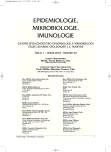The Incidence of Tularemia in Slovakia in 1997-2008
Authors:
D. Guryčová 1; K. Tináková 2; V. Výrosteková 1; E. Gacíková 3
Authors place of work:
Ústav epidemiológie LF UK Bratislava
1; Regionálny úrad verejného zdravotníctva Nitra
2; Štátna veterinárna a potravinová správa Bratislava
3
Published in the journal:
Epidemiol. Mikrobiol. Imunol. 59, 2010, č. 1, s. 39-44
Summary
Study objective:
Analysis of epidemiological trends in tularemia in the Slovak Republic (SR) over the last 12 years and changes in the epidemiology of this infection.
Material and methods:
The sources of data for the epidemiological analysis are the SR annual tularemia surveillance report, records of epidemiological investigation of reported cases and knowledge from long-term surveillance of natural foci. The incidence of tularemia was analyzed based on the standard epidemiological indicators and in relation to infection sources and transmission routes.
Results:
In 1997-2008, a total of 453 tularemia cases were reported from all administrative regions in Slovakia, the mean incidence was 0.71/105 population and 95.4 % of cases were reported in the West, with the predominance of cases in the Nitra region where the mean incidence was 4/105 population. In the outbreak of 2002, the incidence of tularemia was as high as 18 cases/105 population. Tularemia cases were reported in all age groups and more than half of the patients were aged between 30 to 59 years. Tularemia cases were 1.9 times more frequent in males than in females. The seasonal trend peaked in summer, month of July. In a greater proportion of cases, 58.5 %, the source of infection was other than brown hares, 16.3 %, which correlates well with the decrease in the hare tularemia foci in the study period. The most frequent route of transmission was work exposure to contaminated animal feed and bedding and in an dusty environment with increased occurrence of small rodents. The proportion of tick-borne and biting insect-borne cases was 12.8 % and 12.4 % of cases were not elucidated epidemiologically. Clinical manifestations were ulceroglandular and glandular tularemia in 55.6 %, pulmonary tularemia in 21.2 %, oroglandular tularaemia in 18.8 % and other forms of tularaemia in 4.4 %.
Conclusion:
The changes in the distribution of sources of infection and routes of transmission resulted in changed epidemiological characteristics and clinical forms of tularemia in Slovakia. The importance of tularemia surveillance is underlined.
Key words:
tularemia – epidemiological characteristics – Slovakia 1997-2008.
Zdroje
1. Černý, Z. Tularémie – starý i nový problém jihomoravského regiónu. Bratisl Lek Listy, 2000, 101, 7, 402-408.
2. Ellis, J., Oyston, P. C. F., Green, M., Titball, R. W. Tularemia. Clin Microbiol Rev, 2002, 15, 4, 631-646.
3. Guryčová, D., Letkovský, J. Desať rokov výskumu tularémie na Slovensku. Bratisl Lek Listy, 1973, 60, 3, 282-295.
4. Guryčová, D. Analýza výskytu a transmisívneho prenosu tularémie na Slovensku. Epidem Mikrobiol Imunol, 1997, 46, 2, 67-72.
5. Guryčová, D., Varga, V., Výrosteková, V., Gacíková, E., Péči, J. Epidémia tularémie na západnom Slovensku v rokoch 1995-1996. Epidem Mikrobiol Imunol, 1999, 48, 3, 97-101.
6. Guryčová, D., Výrosteková, V., Khanakah, G., Kocianová, E., Stanek, G. Importance of surveillance of tularemia natural foci in the known endemic area of Central Europe, 1991-1997. Wien Klin Wochenschr, 2001, 113, 11-12, 433-438.
7. Guryčová, D. et al. Surveillance zoonóz. Slovenská republika. Tularémia 1997- 2001. Bratislava: Štátna veterinárna a potravinová správa SR, 2004. 82 s.
8. Guryčová, D. et al. Surveillance zoonóz. Slovenská republika. Tularémia 2002 - 2005. Bratislava: Štátna veterinárna a potravinová správa SR, 2007. 65 s.
9. Christova, I., Velinov, T., Kantardjiev, T., Galev, A. Tularaemia outbreak in Bulgaria. Scand J Infect Dis, 2004, 36, 11-12, 785-789.
10. Janda, A., Fencl, F., Kabelka, Z., Hobstová, J., Kroča, M. et al. Tularémie: vzácná příčina horečky a lymfadenopatie v kojeneckém věku. Čes.-slov Pediat, 2008, 63, 3, 137-147.
11. Pazdiora, P., Morávková, L., Nocardová, D., Velkoborská, M., Valečková, K. Vodní epidemie tularémie v Chlumčanech. Epidem Mikrobiol Imunol 2002, 51, 1, 23-25.
12. Petersen, J. M., Schriefer, M. E. Tularemia: emergence/re – emergence. Vet Res, 2005, 36, 455-467.
13. Tärnvik, A., Priebe, H. S., Grunow, R. Tularemia in Europe. An epidemiological overview. Scan J Infect Dis, 2004, 36, 350-355.
14. Treml, F., Hubálek, Z., Halouzka, J. et al. Analýza výskytu tularémie na okrese Břeclav v letech 1994-1999. Epidem Mikrobiol Imunol, 2001, 50, 1, 4-9.
Štítky
Hygiena a epidemiologie Infekční lékařství MikrobiologieČlánek vyšel v časopise
Epidemiologie, mikrobiologie, imunologie

2010 Číslo 1
- Diagnostický algoritmus při podezření na syndrom periodické horečky
- Stillova choroba: vzácné a závažné systémové onemocnění
- Perorální antivirotika jako vysoce efektivní nástroj prevence hospitalizací kvůli COVID-19 − otázky a odpovědi pro praxi
- Choroby jater v ordinaci praktického lékaře – význam jaterních testů
Nejčtenější v tomto čísle
- Životní jubileum prof. MUDr. Vladimíra Janouta, CSc.
- Nocardia farcinica jako původce abscesu mozku u pacienta s intersticiálním onemocněním plic
- Výskyt tularémie na Slovensku v rokoch 1997 – 2008
- Exotickí domáci miláčikovia ako potenciálny zdroj salmonel
